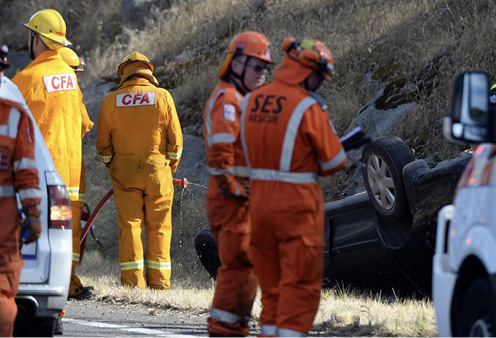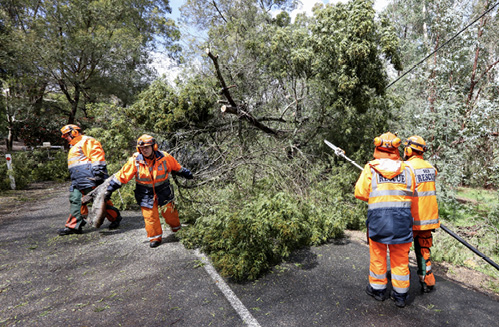New natural hazards science for Australia
Nathan Maddock, Bushfire and Natural Hazards CRC
Article
An exciting series of new research has begun at the Bushfire and Natural Hazards CRC, with nine new projects now underway. Joining the existing platform of natural hazards science these new projects cover mental health and wellbeing, coastal management, emergency management capability, risk communication, land-use planning, sustainable volunteering and recovery post-disaster. Marking the next phase of national research into natural hazards, the projects will support fire, emergency services and land managers as they work to prevent, prepare for, respond to and recover from natural disasters.
The new projects are:
- National mental health and wellbeing study of police and emergency services
- Forecasting impact for severe weather
- Urban planning for natural hazard mitigation
- Flood risk communication
- Diversity: building strength and capability
- Catastrophic and cascading events: planning and capability
- Hazards, culture and Indigenous communities
- Factors affecting long-term community recovery
- Enabling sustainable emergency volunteering.
New science
In conjunction with beyondblue1, up to 20,000 current and former personnel from 35 police and emergency organisations across Australia will be asked to participate in a survey about their mental health and risk of suicide. The ‘National mental health and wellbeing study of police and emergency services’ will be undertaken by the University of Western Australia. It will develop evidence-based strategies to support individuals, improve organisational culture and address systemic concerns that impact on mental health and wellbeing. These strategies will be developed in collaboration with a cross-section of the police and emergency services sector including agencies, unions, government departments, individuals and family and community groups
The ‘Forecasting impact for severe weather project’, led by the Bureau of Meteorology and Geoscience Australia, will develop a pilot capability to make useful predictions of the effects of extreme weather to influence people to take actions to reduce damage. It will focus on case studies along the east coast, looking at damaging winds, flooding and heavy swells.
The ‘Urban planning for natural hazard mitigation project’, led by the University of Melbourne and the University of Adelaide will produce new and innovative ways of integrating urban planning and natural hazard risk management. It will increase the understanding of what planning and emergency management can and cannot do, separately and in synergy. It will develop new approaches to applying tools and methods available to planning systems to the design and management of communities as they change.
Previous CRC research has showed that most flood fatalities are avoidable. Continuing this line of research, the ‘Flood risk communication project’ will develop an understanding of the motivations, beliefs, decision-making processes and information needs of at-risk groups for flood fatalities. Led by Macquarie University, the study will cover both age and gender, including an understanding of what a Plan B would look like, how to motivate proactive decision-making ahead of the journey, what the current challenges and barriers are to this and what further support and information is needed. Outcomes from this project will include targeted risk communication materials.

For the first time, emergency services and police across Australia will be surveyed about their mental health and wellbeing. Image: CFA
The ‘Diversity: building strength and capability project’, led by Victoria University, will investigate how diversity is understood and practiced in emergency management. The project will identify the constraints and enablers to implementing inclusion activities and understand how diversity can serve to enhance the current operational environment and systems.
The ‘Catastrophic and cascading events: planning and capability project’, led by Macquarie University, will identify ways to improve management approaches to catastrophic events. These events can take many years to recover from, with many of the effected population choosing to relocate to other areas permanently. Economic losses can be severe as industry is disrupted, businesses close and further demands for capital injections from government are made to support recovery costs.
The ‘Hazards, culture and Indigenous communities project’, led by Western Sydney University and Deakin University, will investigate the hazard priorities of diverse Indigenous communities in southern Australia and the emergency management sector’s engagement with these communities. The project will conduct collaborative research with Indigenous peoples and emergency management practitioners to explore how better engagement can be supported, with a focus on the interaction of scientific, Indigenous and other knowledge sources.
The ‘Factors affecting long-term community recovery project’, led by the University of New England and Massey University, will investigate two complementary areas of research relating to the long-term recovery of communities after a disaster. The first area looks at community connectedness from the perspective of people who move home often and live in different locations and the role this plays in both their and the community’s social recovery after an emergency. The second area will use case studies to examine the enablers and barriers to successful recovery, looking at natural, cultural, human, social, political, built and financial capital.
The ‘Enabling sustainable emergency volunteering project’, led by RMIT University and the University of Western Australia, will investigate how to adapt the emergency management sector to new ways of volunteering, and the change management practices required to achieve this.

SA SES volunteers cleaning up after a storm. Research is examining the change practices required by emergency services to adapt their volunteering strategies. Image: South Australia SES
These important new projects build on the existing foundation of natural hazards research established by the Bushfire and Natural Hazards CRC in 2013. The CRC has reached an exciting point in its existence with many of the many of its projects coming to maturity. Some of the original projects have been finalised while many others are set to begin next stages. These nine new projects broaden the scope of the national natural hazards research and offer vital outcomes for fire, emergency services and land managers and, through them, Australian communities.
.
New research will investigate planning for catastrophic events.Image: Mick Reynolds, NSW Rural Fire Service
Footnotes
1 beyondblue is an Australian, independent non-profit organisation addressing issues associated with depression, anxiety disorders and related mental disorders. At: www.beyondblue.org.au.


